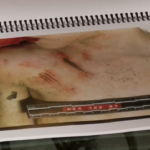As part of research for the next TWO FACE book I’ve investigated an area that’s new to me. I haven’t encountered it elsewhere in true crime. It’s the impact of crude oil on a cadaver, and on stomach contents.
In the West Memphis 3 case, three eight-year-old boys were submerged for about 24 hours in a swamp. The defense tried to argue that ligature wounds suffered by one of the victims were inflicted by wild animals [snapping turtles]. Since the bodies were recovered early, and the medium was fresh water, the wounds were fairly well preserved.
A more analogous case in terms of similarity to the substance the Watts children were suspended in is the murder of British children’s author Helen Bailey. Bailey’s murder was also labelled a missing person’s case for several weeks until her remains were finally discovered. Ian Stewart dumped his fiance and her dog into a cesspit.

It took three months to find her remains, and when they did, the only tissue that had any forensic value was the woman’s hair. Even so, they found varying levels of the sedative Zopiclone in Bailey’s hair, a sign that Stewart had surreptitiously and strategically added to her food in gradually increasing doses.
The Casey Anthony case also involves fairly complex human decomposition involving water, air, heat, and various organisms, from bacterial microorganisms to larger scavengers. But in all these cases there’s no crude oil.
Even in the authoritative Knights Forensic Pathology, the coverage of this subject is minimal and insufficient.

I did find three separate cases that involve crude oil in some way, and although none of the three answer the question about whether the stomach contents would be destroyed by the oil, they each provide a separate insight.
For the first insights we have to drift back in time 35 years ago, to May 7, 1983.
Two of three victims found stuffed in oil drums… – UPI.com
Two of three victims found stuffed in oil drums in Golden Gate Park have been identified …Surdyka said coroner’s technicians were having difficulty identifying the other victim because of the body’s decomposed state. Investigators were able to obtain fingerprints from the bodies of Thomas and Ms. Melendez.
The coroner also put the two painted barrels in which police found the bodies on display to the media because they hoped someone would come forward to identify them if pictures of the 55-gallon drums were publicized by the media.
‘We know where one of the barrels was manufactured,’ Coroner Boyd Stephens said, ‘but the serial number was worn off so we don’t know where it was shipped. We don’t have any good clues about the others. ‘So we’re hoping somebody might recognize one of the barrels if they see a picture on television or in a newspaper and give us some information.’
All three victims had been shot execution-style in the back of the head, the coroner said, but refused to say whether the bullets were the cause of death since there was some possibility the shots could have been fired to conceal the true cause of death, or to make sure they were dead.
Neither would he say how long the bodies had been in the 55-gallon drums discovered near some bushes in Golden Gate Park. Investigators retrieved the bullets shot into the victims, but a detective said they ‘don’t look good’ and probably are too damaged to provide information about what kind of gun was used.
He said the drums were probably dumped in the park early April. At that time a witness heard ‘two loud thumps’ and saw three cars near the place where the barrels were found.
What do we learn from this? If the drums were dumped in early April, and discovered in early May, then this was sufficient time for the bullets to corrode so they couldn’t be traced back to a weapon. Also, one victim had “dissolved” beyond the point that she could be identified. This doesn’t mean the oil was responsible, because the body could have been placed in the drum after having decomposed elsewhere, but it does suggest the oil is effective at destroying evidence, including time-of-death and manner-of-death evidence.

Next we jump forwards in time from San Francisco to Sheffield England, circa 2005.
Tycoon ‘shot lover in car and sealed her body inside oil drum’ – The Telegraph
Howard Simmerson, 43, is claimed to have planned the murder of his lover Julie Turner… He sealed her body in an oil drum and placed it in the back of his pick-up truck and spent the next 40 hours driving around looking for a place to dispose of it, Sheffield Crown Court was told.
During that time he called at a remote farm and had sex with Charlotte Melland, another girlfriend, allegedly leaving the corpse outside in his vehicle.
Peter Kelson, QC, prosecuting, said Simmerson sent bogus text messages after the killing purporting to be from Miss Turner to cover up his “callous and gruesome” crime. Simmerson, who runs a gas bottle distribution company, lavished expensive presents on Miss Turner during a four-year relationship while she was living with her common law husband.
Initially he told police he had dropped her off near her home at her request on the night she died, but later claimed that she was shot in the Mercedes with the gun in her own hand. An Italian Derringer double-barrel pistol was later found at his business premises.
Miss Turner, of Sothall, Sheffield, had a long-term partner, Darran Akers, by whom she had two sons aged 14 and nine. She began a relationship with Simmerson, who is single, in 2001, but she continued to live with her family.
Simmerson and Miss Turner went to a promotional evening on June 7 at Harvey Nichols in Leeds. They left shortly after 10pm and Miss Turner was shot in the right side of her head in the passenger seat of his Mercedes. Simmerson then drove home, folded her body into an oil drum which he put on the back of an open-backed red Ford Ranger.
He was filmed on CCTV cameras driving around Derbyshire’s Peak District allegedly trying to find somewhere to dispose of the body. At the same time he is claimed to have sent text messages from a mobile telephone. One was to Mr Akers, purporting to be from her. The text read: ‘Staying at Gill’s. Back later. Need to sort my head out.’
At breakfast-time Simmerson had the barrel professionally welded shut and drove out to the Mellands’ farm. Mr Kelson said: “He ended up at Charlotte Melland’s and they had sex for the first time, as he had said he would not have sex with her while he was still seeing Julie.” The next day, Simmerson had the car valeted in Chesterfield telling an employee he had “knocked a dog over and put it in the passenger seat”.
Mr Kelson told the jury Simmerson was to tell police that Miss Turner had pulled the gun on him and “jabbed” it in his face. He claimed that he was trying to disarm her when it went off accidentally and he had no intention of harming her.
Simmerson, of Creswell, Derbyshire denies murder.
The Simmerson case involves many of the same elements as the Watts case: sex with a second mistress, caught out by CCTV cameras, driving out to a remote location in a pick-up truck, the adapting of a story from a disappearance to an argument leading to an accident, the sending of bogus text messages etc.
Body of man found sealed in oil drum and dumped in river – The Scotsman
POLICE are investigating the murder of a man whose body was discovered sealed in an oil drum floating in the Clyde. He was discovered by workers who had been carrying out routine cleaning and dredging work midway between Old Kilpatrick and Erskine, close to the Erskine Bridge.
Strathclyde police said that the unidentified body, said to be that of a man more than 6ft tall with “a stocky, hefty build”, had been in the water between three and 14 days before it was found.
The body was brought ashore at Old Kilpatrick after it was found on Thursday morning. It had been crammed into an oil drum, which had then been sealed. It is understood that the man had not been dismembered before being placed in it. Detective Chief Inspector Neil Thomson of Strathclyde police said the victim had been subject to a “brutal attack” prior to his death and the priority now was to identify him.
“On the small finger of his left hand was a gold metal ring with the word ‘Dad’, which appears to have some sort of stones or jewellery encrusted in it,” DCI Thomson said. “On the wedding finger of the same hand was a fairly large, square-shaped gent’s signet ring, which also has a square-shaped design on top of it. It’s quite a chunky ring.” The victim was found wearing a polo-style shirt with the Yves Saint-Laurent brand name emblazoned right across it, rather than the more usual YSL logo. Police have been unable to give a specific age for the dead man, placing him between 20 and 50. DCI Thomson would not say whether this was due to the injuries the victim had sustained or because of the time spent in the water, stating instead that it could be “notoriously hard” to identify age purely by external examination.

This last example appears to involve an oil drum, but no oil. Nevertheless, the identity of the man is unknown, so much so it’s unknown whether he was young or middle-aged, despite only being in the water for a few days.
It does raise the question – were the children dumped into the tanks in their clothes, and if so, what were they wearing? Were they wearing their pajamas?













Leave a Reply